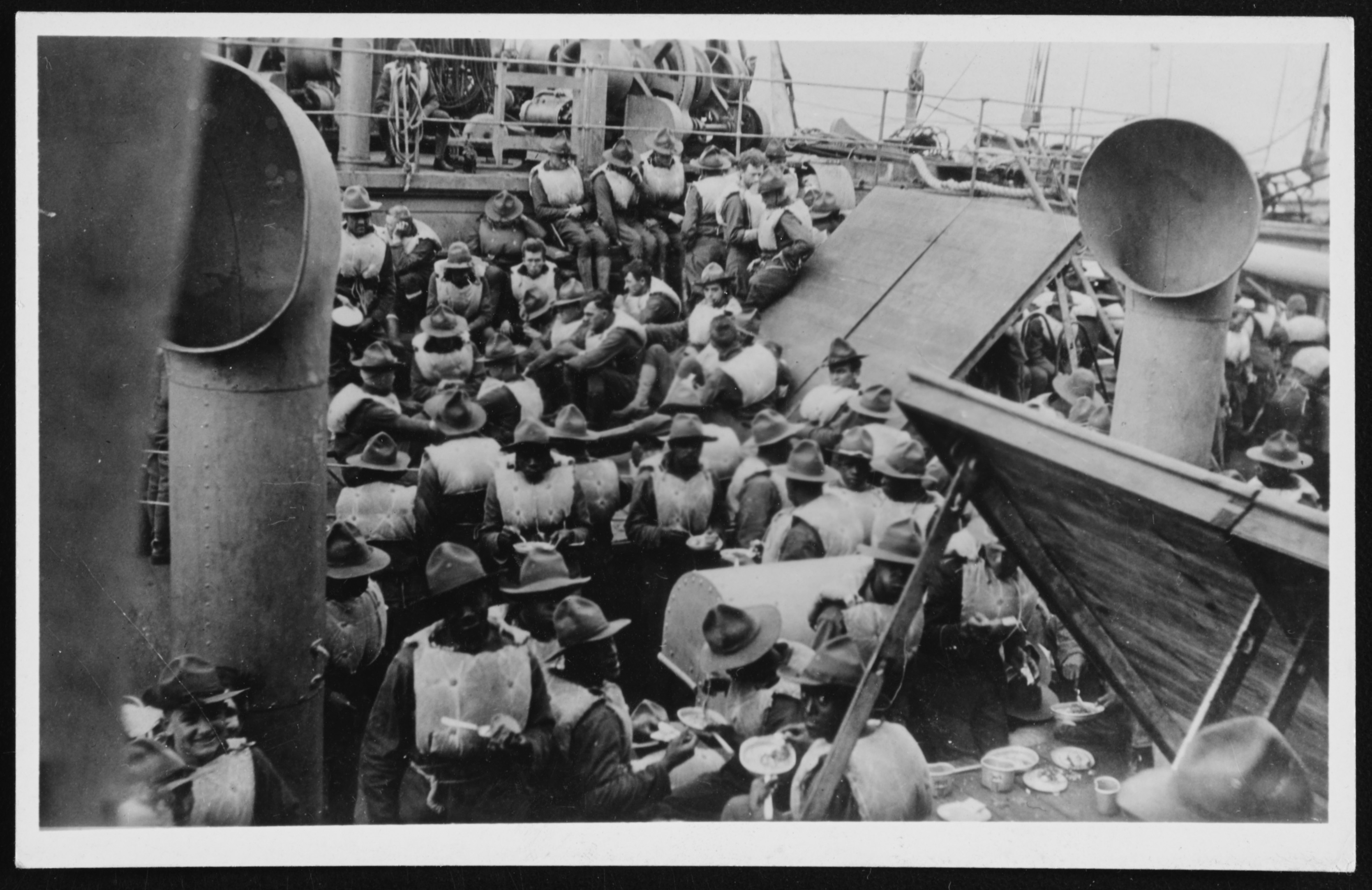In late 1917, an American soldier risked government censors’ wrath to sneak home a letter about dodging German submarines while aboard a troopship headed for war
The following transcription is from a two-sided carbon copy found inside a book the editor of this magazine bought for a dime at an estate sale in the American University Park neighborhood of Washington, DC, in the 1980s.
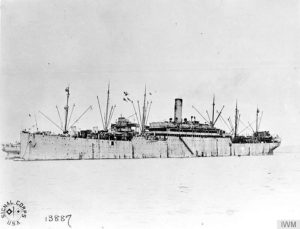
Just after Christmas 1917, an American soldier named Stan boarded the troopship USS President Lincoln in New York harbor for the journey to France, where he would become one of 4.3 million doughboys to join British and French troops in the war against Germany, the Austro-Hungarian Expire and the Ottoman Empire.
The vessel had originally been a Hamburg-America Line passenger ship bearing the same name. Seized by the U.S. Navy in New York harbor in the first months of 1917, President Lincoln became one of roughly 100 German and Austrian ships pressed into the Allied war effort.
Stan had trained at Camp Mills, a U.S. Army installation established in September 1917 on Long Island, New York. The camp was named for Major General Albert A. Mills, a former superintendent of the U.S. Military Academy awarded the Medal of Honor for service during the Spanish American War. The camp, created to train National Guard troops mobilizing as the 42nd Division and whose ranks included Col. Douglas MacArthur and F. Scott Fitzgerald, became an Army Air Corps airfield and eventually was developed into Garden City, New York.
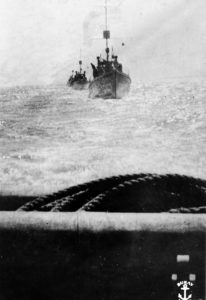
After leaving New York, President Lincoln almost immediately faced German U-boats, which at the height of their effectiveness between October 1916 and January 1917 had sunk 1.4 million tons of Allied shipping, nearly cutting Britain off from its food sources. Anticipating U.S. entry into the war and the threat submarines posed, Assistant Navy Secretary Franklin Roosevelt ordered American shipbuilders to design and manufacture fast, nimble, 110-foot, 85-ton wood-hulled craft called submarine chasers to protect convoys of transports and merchant ships.
(Of 441 subchasers built, France bought 100, and 121 were deployed off Britain, France, and in the Mediterranean. Armed with machine guns and depth charges, chasers patrolled American coastal waters and guarded convoys. Six were lost during the war. After the war several were converted to civilian use as trawlers; 14 were transferred to the U.S. Coast Guard. Others remained in military service abroad, with a few seeing action during World War II. These matchstick men-of-war protected President Lincoln and the fleet of troopships that took doughboys like Stan to war.
On Board the U.S.S. President Lincoln
In the harbor at Brest,
France, Dec. 29, 1917
Dear Al:
One of the sailors is going to take this letter back to New York and mail it for me so as to avoid censorship. That is the reason I’m telling you the name of the place we have landed at (or rather going to land at, because we have been lying in the harbor here for the last few days). We got here the 27th.
The orders read that we disembark tomorrow morning at 9 a.m. You will have to excuse the writing and everything else as I go on guard at 12 and it is after 11. Then they wake us at 4 a.m. and I wont’ [sic] have another chance to write in time to give it to the sailor before we leave the ship. I don’t come off guard until 2 a.m.
Pop and I never even had a touch of seasickness on the trip. Quite a few of the men were sick, although the motion didn’t seem bad to me.
We pulled out of Camp Mills on the Wednesday morning after Pop went home on his last visit. We laid in New York harbor until the night of the 14th waiting for the other transports. There were six transports and one battle cruiser in the fleet. It wasn’t until Christmas morning when we woke up that we saw the rest of our convoy. They had just joined us the night before sometime. All the way across we had had only that one cruiser for our convoy. The rest of the convoy that met us on Christmas Eve was ten submarine chasers. They are about the fastest things afloat—capable of making about 35 miles an hour. Of course they could dodge the torpedoes of the submarines and be peppering them all the time. They are rather heavily armed for their size, so they are really the only things afloat that a “Sub” is afraid of.
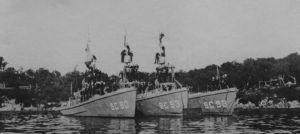
About two days off the coast of France three of the transports and half of the convey left us and went on to St. Nazaire while we cut off and came north to Brest. On leaving New York we understood that all of us were to go to St. Nazaire, which is at the mouth of the Loire River, on the Bay of Biscay. Tell Lydia to look it up in her geography so she can see where we are. (Of course, I mean Brest) The way I explained things above made it look as though I meant St. Nazaire.
This is the Doughboy little harbor Al. You can see across it at the widest part and with the glasses you can plainly see the fishermen’s quaint little homes perched up on the hillsides. They are the cosiest looking little places you ever saw. We haven’t been able to get a good look at the city of Brest as yet because the water isn’t deep enough for our ship to be towed up to the docks. I’m afraid we won’t be able to see much of the town anyway as they have already posted orders on the bulletin board as to the actions and behavior of the men aboard the train. So they must be figuring on getting us right on the train and shipping us to some point in the interior. There’s a rumor that we may do provost duty in Paris, but I hardly think that’s true. It’s too good to be true. Say lady, supposed they’d load us on the train and run us right up to the trenches. Wouldn’t that be some New Year’s presenet [sic].
All the fishermen bring their wives and families out in their fishing boats to see the transports and men on board drop them money and candy and all kinds of things. It’s the girls though who get the money. Two swell looking dames came out in a boat by themselves and both of them got their bonnets full of change.
There’s a man in this regiment who deserted the French Army and went to the States where he was caught in the draft and now is bad [sic] again with us. Should he be recognized it would mean the firing squad for him. Nice outlook eh!
The food has been pretty good all the way over, but the menu lines are blamed long. They put out a good Christmas dinner, but so many men slipped in for seconds and even thirds that some of us only got about half of what we were due. I got mine. By the way one of the sailors took movies of us eating Christmas dinner so in case you see any of the pictures of the transport Pres. Lincoln of men eating look out for me. I think I’m pretty conspicuous. At least I tried my best to be in hopes that some of the folks might see me.
Did you get my box? I haven’t been paid yet so I couldn’t send you the price, and besides I don’t know yet what it cost. I don’t even know whether the man expressed it or not. It was my only chance. I had to take it or leave the box in the camp.
Listen Al, the very first chance you get open the box, break it open if necessary and (if course if you got it) and send the sweater in there to A.S. Boxwell, 607 Pine St., Wilmington, Delaware. Call up Anna and ask her if that’s the right number. Please do that for me Al. It won’t cost much.
Tell Billie that Grandpop said he will sure bring something fine when we come home.
I am closing now, Al, but will write again as soon as we get settled down. Every chance I get I’ll slip a good letter by the censors to you folks. Love to all.
Stan.
Hq. Co., 161st Inf
A.E.F. via New York
P.S. 1
Tell Lydia to please send me all the pictures she can get. Especially the one I asked her to get of Anne at the drug store at 9th & F Sts.
P.S. 2
Pictures of anybody I happen to know. Something to look at.
***
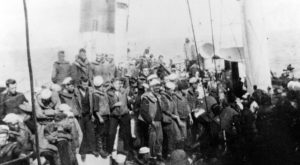
President Lincoln made five voyages from New York carrying some 23,000 American troops to Brest and St. Nazaire, France. Four trips were without incident. Departing Brest on May 29, 1918, with three other troopships and accompanied by destroyers and subchasers, Lincoln passed safely through the portion of the Atlantic deemed dangerous, whereupon the escorts left the convoy. On May 31 German submarine U-90 torpedoed Lincoln, which sank in 20 minutes, taking down 26 of the 715 men aboard.

